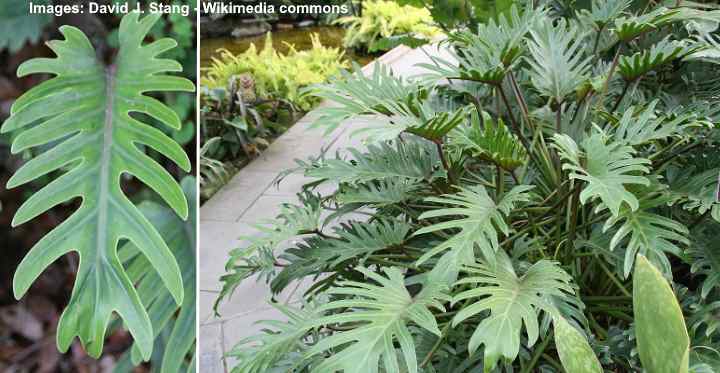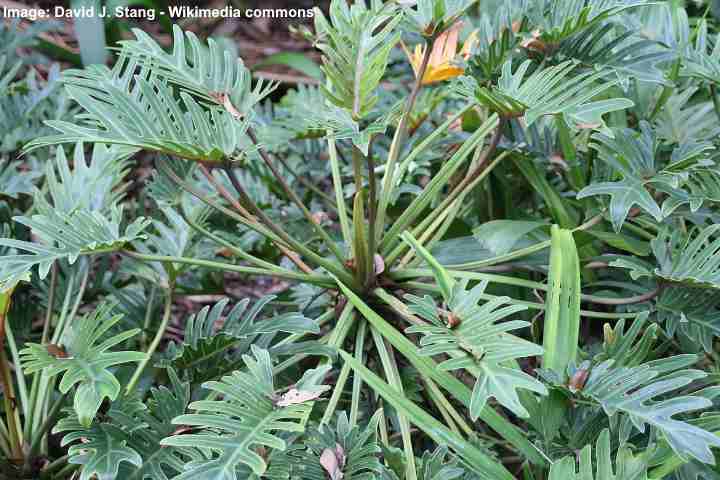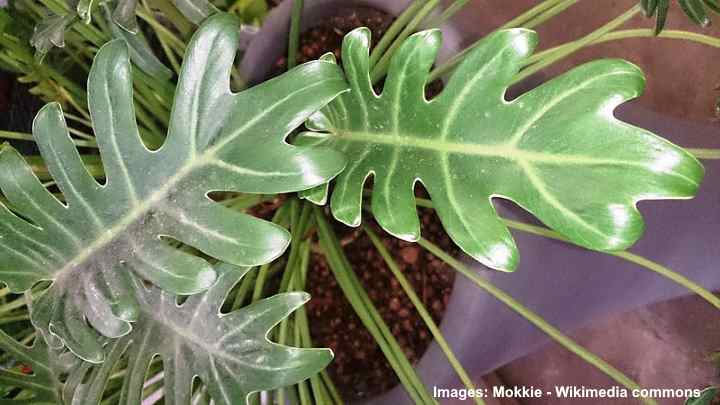Philodendron Xanadu Plant: How to Grow Philodendron Winterbourn

The Philodendron Xanadu (Philodendron bipinnatifidum ‘Xanadu’) is an evergreen tropical plant with glossy green, deeply lobed leaves. The Xanadu plant thrives indoors and is classed as an easy-to-care-for houseplant. Also called the Philodendron Winterbourn, this tropical indoor plant grows to about 5 ft. (1.5 m) high. With the right care and attention, you can easily grow a Philodendron Xanadu indoors.
How to care for Philodendron Xanadu? Grow your Xanadu plant in rich, well-draining soil, water when the top 1” (2.5 cm) of soil is dry to keep the potting soil moist. Place your Xanadu plant indoors where there’s bright, indirect light and fertilize monthly during the growing season. Keep temperatures between 65°F and 82°F (18°C – 28°C) and high humidity levels.
Also referred to as Philodendron Winterbourn, the Xanadu plant is a type of flowering tropical plant when grown outdoors. In its native environment, the plant thrives in tropical and subtropical climates. The Philodendron Xanadu flowers outdoors with dark red spathes. However, indoors, the plant rarely blooms.
The fast-growing Xanadu plant grows in dense clumps up to 6.5 ft. (2 m) across, and is characterized by shiny, thick foliage.
This article provides a complete guide to caring for a Philodendron Xanadu plant indoors. You will also find some great growing tips to keep your tropical houseplant healthy and free from disease.
What is a Philodendron Xanadu?

All types of Philodendron belong to the plant family Araceae. The ‘Xanadu’ is a cultivar in the Philodendron bipinnatifidum species. This species of Philodendron is a clumping plant, rather than a trailing vine plant such as the heartleaf Philodendron.
The distinguishing feature of the Philodendron Xanadu is its deeply lobed leaves. As the waxy leaves grow and mature, they develop long finger-like shapes along the leaf stem. The large evergreen leathery leaves can measure up to 15” (40 cm) long and 11” (30 cm) wide.
Philodendron Xanadu Plant Care
Like most species of Philodendron, the Xanadu cultivar is an easy houseplant to care for. However, there are a few essential care requirements to ensure you grow a healthy plant indoors. The main factors in caring for a Xanadu plant include:
- Making sure it gets adequate bright, filtered light to ensure dense foliage growth.
- Planting in a well-draining potting mix to prevent root disease.
- Keeping humidity high to help the plant thrive indoors.
Light Requirements for Philodendron Xanadu

Grow the Philodendron Xanadu in a bright location where it gets filtered or indirect sunlight. Medium to bright light prevents the thick stems from becoming leggy and unsightly. Protect the houseplant from direct sunlight as the sun’s rays can bleach the dark, green glossy leaves.
Most types of Philodendron plants can grow well in shaded areas or low-light conditions. However, the Xanadu plant needs more sunlight than most species in the Araceae family. One sign that your plant isn’t getting enough light is slow growth that becomes sparse and leggy. Rather than dense growth, stems may start growing leaves that have several inches of space between them. So, it is best to avoid putting Xanadu plants in dark areas, shaded corners, or north-facing rooms.
Getting enough bright light will also affect other care requirements. If the indoor location is bright and sunny, you will have to water your plant more frequently. When a Philodendron grows in medium light, you will have to adjust your watering schedule. If you notice that the plant loses its sturdy growth habits, you may need to move it to a brighter location.
Philodendron Xanadu Soil Mix
Potting soil for Philodendron Xanadu should be a rich, loose soil mixture that drains well. The right soil mix should retain just enough water without becoming overly damp or waterlogged. The best type of soil should allow water to drain quickly from the drainage holes.
What are the best ingredients to use for planting Philodendrons, such as Xanadu? Potting soil should be rich in organic matter such as peat moss so that it doesn’t dry out too quickly. You can also mix in perlite, charcoal, or coconut fibers to help aerate the soil. A light potting mix will provide the perfect growing medium for your tropical plant.
These plants will also grow well in 100% sphagnum peat moss.
Signs that you may need to change your potting soil include:
- Water doesn’t drain well because it’s too dense.
- The Philodendron is growing slower than normal.
- Water pools on the soil’s surface because it’s too heavy, or the plant is rootbound.
Later in the article, you can learn how to repot a Philodendron Xanadu.
How to Water Philodendron Xanadu

Only water a Philodendron Xanadu when the top part of the soil has dried out. To check if the plant needs watering, press firmly on the soil. If there is no sign of moisture, thoroughly water the plant. If you still feel some dampness, wait a few days until the soil in the pot dries.
The right watering technique for houseplants is essential in caring for your Xanadu properly. With many types of indoor plants such as the Xanadu, it is best to water less rather than more. Overwatering can result in fungal diseases that can even kill your houseplant. Under-watering can dehydrate your plant.
Remember, it is easier to revive an underwatered Philodendron than save a waterlogged plant. If you always use soil dryness as a guide to watering your plant, your Philodendron Xanadu should live for many years. As a general rule, check that the top 1” to 2” (2.5 to 5 cm) is completely dry before soaking the soil.
Why is thoroughly watering a Philodendron better than shallow watering? Deep watering allows enough moisture to get to the roots. Healthy roots help boost plant growth and make it resistant to disease. If you make the mistake of watering a little and often, you risk damaging your plant. Shallow watering starves roots of moisture and creates an environment for fungus gnats to thrive or white plant mold to develop.
Top care tip: Never let a Philodendron plant sit in water, or you risk dampness damaging the roots.
Philodendron Xanadu Temperature Requirements
Philodendron Xanadu plants thrive in average household room temperatures. The ideal temperature range is between 65°F and 82°F (18°C – 28°C). You may notice that the plant grows faster if the minimum temperature is 73°F (23°C). If you grow your Philodendron in a container outdoors, avoid any temperature below 55°F (12°C).
Tropical plants such as Philodendron, Monstera, and hanging basket Pothos plants need to grow in even temperatures. So, try to avoid temperature extremes inside your home. Getting a nice temperature can be challenging in hot or cold weather. Here are some tips for growing Philodendrons in the different seasons:
- Growing Xanadu plants in summer—Keep plant pots out of drafts from open windows or doors. Also, move the plant location if it’s in the air-condoning airflow. Don’t let the hot sun’s rays shine directly on the plant through a window.
- Growing Philodendron Xanadu in winter—Protect the plant from hot surfaces such as radiators. Check the plant’s humidity levels as heating can make indoor air drier.
How to Care for Philodendron Xanadu: Humidity

High humidity is needed to keep your Philodendron Xanadu growing well. Household air tends to be too dry for many tropical plants—Xanadu included. It’s necessary to increase humidity levels to at least 40% for fast, healthy growth. Boost air moisture by regular misting, placing on a pebble tray, or using a humidifier.
How can you make sure that your tropical Xanadu plant gets enough humidity? Here are a few ways to look after your plant:
- Mist the leaves—Fill a spray bottle with filtered or distilled water. Spray a fine mist over the leaves every day to help keep the plant’s leaves moist and humid.
- Use a humidifying tray—Fill a shallow tray with small pebbles and pour in enough water until it reaches halfway up the stones. Place the plant pot on the stones. Refill the tray as necessary when the water has evaporated.
- Use a room humidifier—A humidifier can help keep your room at the appropriate humidity levels for your tropical plants.
Philodendron Xanadu plants are excellent shower plants for your bathroom. If you have a brightly-lit bathroom, the regular humidity from showers will help keep your plant thriving.
Fertilizer Needs to Care for Philodendron Xanadu
Fertilize a Philodendron Xanadu by using a balanced houseplant food that is diluted by half. Feed your Xanadu plant monthly in spring and fall. During the summer, when growth is vigorous, fertilize the potted plant every two to three weeks. Don’t feed your Philodendrons during late fall and winter.
As with all tropical houseplants such as Philodendron Xanadu, they can suffer from a buildup of fertilizers. That is why it’s important not to overfeed them. Too much fertilizer can burn the roots, which leads to poor growth and yellow leaves.
Flushing the soil occasionally can help to remove harmful chemicals and a salt buildup in the soil. To flush fertilizers from houseplant soil, let the water gently drain through the potting mix for a few minutes. After that, allow all the excess water to drain out and place the plant back in a bright location.
Repotting Philodendron Xanadu

You will need to repot a Philodendron Xanadu, or Winterbourn, every year or two to encourage healthy growth. Repotting gives you a chance to replace the potting mix with fresh soil. Also, transferring the plant to a larger pot gives the roots more space to grow if it’s become rootbound.
As a general rule, choose a pot that is 1” to 2” (2.5 to 5 cm) larger than its current one. You will need a suitable fresh potting mix that has good drainage. Before repotting, it’s a good idea to have pruning shears to trim away any dead or decaying roots. Also, repotting a Philodendron Xanadu gives you a chance to divide the Xanadu plant to propagate it.
To repot your Philodendron Xanadu, this is what you should do:
- Gently ease the Xanadu plant from its existing container and shake off excess soil.
- Inspect the Philodendron roots for damage. Remove brown mushy roots and trim them off as necessary.
- Fill a new container half-full with the appropriate Philodendron potting mix.
- Repot the Philodendron Xanadu plant. Make sure that it’s growing at the same height in the pot as before.
- Fill the remaining space with potting soil.
- Water the Xanadu plant thoroughly.
- Place the Philodendron Xanadu in an indoor location that has medium to bright light.
Pruning a Philodendron Xanadu
It’s not usually necessary to trim a Philodendron Xanadu. However, if its growth becomes leggy or the plant becomes too big, you could prune off some of the stems. Pruning may be required if dead or dying leaves appear. To trim your Xanadu plant, just cut off the leaves at the base of the stem.
Philodendron Xanadu Propagation
Dividing a Philodendron Xanadu is the best way to propagate it. Because this variety is a fast-growing plant, the Xanadu can quickly become too large for its pot. The easiest time to divide a Xanadu is when you repot it. This way, you can grow two new plants and give one as a gift.
To propagate a Philodendron Xanadu plant, this is what you should do:
- Carefully remove the Xanadu plant from its pot.
- Gently ease the roots apart because they will probably be entangled.
- Divide the Xanadu plant’s root ball into two.
- As when repotting, check for and remove and dead roots.
- Repot both plants in new pots.
After propagating a new plant, continue caring for both plants as normal and only water when the soil is partially dry.
Treating Philodendron Xanadu Pest Infestations
Philodendron Xanadu is susceptible to houseplant pests. It’s important to treat any houseplant pest infestations promptly. If left untreated, the pests could kill your plant and infest more of your prized indoor plants. To treat these pests, use a neem oil solution as a natural pesticide.
Getting rid of pests successfully requires identifying the type of bug on your plant. Please see this article on how to identify houseplant pests to find out more.
Correct watering techniques are one way to avoid some types of pests. For example, keeping humidity levels high helps prevent spider mites—these plant-destroying pests love dry air. Allowing the top layer of soil to dry before watering also helps prevent fungus gnats—these pests thrive in damp conditions near the soil surface.
Philodendron Xanadu Diseases
Xanadu plants are prone to bacterial or fungal diseases if you don’t care for them properly. The best way to prevent indoor plant disease is to water them properly. Letting the soil partially dry between deep watering helps prevent too much soil moisture.
Soggy or waterlogged soil can lead to fungal spores multiplying in the soil. Bacterial diseases can cause root rot and leaf spot. If you notice signs of plant disease, you should repot the plant to refresh the potting mix. After that, water the Philodendron only when it needs it to prevent soggy soil.
Is Philodendron Xanadu Plant Poisonous?
The Philodendron Xanadu is a toxic plant because it contains calcium oxalate substances. The American Society for the Prevention of Cruelty to Animals (ASPCA) says that Philodendron plants are poisonous to cats and dogs. Ingesting Philodendron leaves can cause pets to suffer intense burning, irritation, vomiting, and cause difficulty swallowing. (1)
FAQ About Philodendron Xanadu Care
Why are the leaves of Philodendron Xanadu turning yellow?
Leaves can turn yellow on a Philodendron Xanadu for several reasons. However, the most common reason for yellowing leaves is too much sunlight. So, move your plant out of the sun’s direct rays or filter the sunlight.
Yellow leaves are also the result of overwatering. So, make sure that you only water when the soil is partly dry and that the pot provides adequate drainage.
Why are leaves of Philodendron Xanadu turning brown?
Leaves on your Philodendron Xanadu that develop brown bits could be due to watering issues. Brown leaves are an indicator that the roots aren’t getting enough moisture. So, always thoroughly water your plant until water drains from the bottom. Avoid the tendency to water plants frequently and shallowly as you can cause the plant to die of thirst.
How do you fix an overwatered Philodendron Xanadu?
There are two ways to fix a plant that has been overwatered. First, don’t water the plant until the top layer of soil has dried. Second, repot your plant and replace the growing medium with fresh potting soil that drains well.
How do you revive a dying Philodendron Xanadu?
To help bring a dying Philodendron Xanadu back to life, find out the reason why it’s wilting. Check for soil dampness to make sure that watering isn’t an issue. Also, look for signs of bugs or pests on your plant. If necessary, you may have to repot the plant to help revive it.
Related articles:
